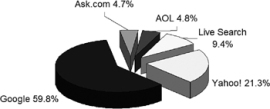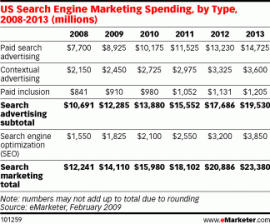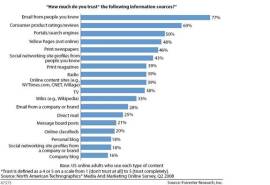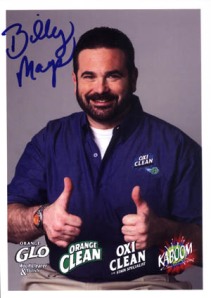Digital Insights
Deep thoughts on the ever-evolving world of new and emerging mediaWithout search engines, you may find yourself singing a U2 song
This week’s discussion centered on the topic of search engines and whether their practices were in our opinions, ethical or not. This issue was largely a result of an article published back in 2002 on the subject. The piece raises the issue that most search engines—Google, Yahoo!, MSN—actually make money through paid placement and paid inclusion. The debate really comes down to if these search sites—vehicles people use mostly to search for something, be it information, news, images, and so on—are making a concerted effort to demonstrate to online searchers which links are paid for, or “sponsored” and which links are not in terms of their ranking and placement.

Google heads the search party
Many of us argued that that there really isn’t an argument here and I’ll elaborate further. First, the ability to search on the Internet is fast, easy and relatively speaking, FREE! This is true, of course, minus the cost of your Internet access. But, to be able to get information—a commodity that was once upon a time unheard of in such a speedy fashion—has empowered consumers to be better, more informed buyers of products and services. And as the sophistication of search engine marketing (SEM) continues to develop over time, organic search results will only grow in terms of their relevance to each and every person based on such online habits/activity as a users search history, geographic location, as well as other demo/psychographics.
In such uncertain economic times, we shouldn’t be debating anything that offers a huge return on such low investment of our time. In this case, it takes virtually nanoseconds to find precisely what we are searching for online. And perhaps ALL search engines weren’t disclosing which links were paid for and which weren’t in a crystal clear way, well, I’d venture to say that was so seven years ago. Take any search engine today and more than likely, there will be some clear way where research results clearly yield a portion of sponsored links, say in a shaded color, for example, while the rest are your organic results. As one marketer put it, “Paid search’s effects are immediate, but marketers need to spend consistently for sponsored-link ads to appear in search queries. SEO takes time, and marketers need to constantly maintain their Websites to sustain high organic results. Customers are going to search engines because they are looking for better deals and marketers are going to search engines because that’s where the customers are.”

In my mind there’s little debate. Consumers are more Web-savvy than ever and they are increasingly relying on search engines to show them where the best deals are. And what better time than now to get the most for what we fork out of our pockets? If sponsored links appear in our net results when we search—much like a DVR device—we can either fast forward through the commercial (in this case ignore the paid links) and return our gaze on the organic, net result of our search. The difference here is that if you find yourself searching for something like say a new “coffee maker,” you might be interested in the discounted offers that Gevalia, KitchenAid, and Krups paid big money for you to see first.
In Blogs We Trust? There May Still Be Some Work To Do
First off, I want to apologize for the delay since my last posting. Life surely doesn’t stop for anyone, as we’re all given an equal amount of time to work within any given day. The trick is how well can you focus on what’s most important to achieve your highest priorities, as well as balance – all in the same effort. This just happens to be an area I’m working dilligently on, with plenty of refining to do.
Having said that, our discussion during Week 3 focused on the unrelenting superpower of the modern consumer voice—and how blogs are being used as yet another communications vehicle (mind you in a world suffering from information saturation) to reach a given audience. The stealth behind this increasingly popular medium is not only inherent in the fact that 1) It’s virtually free; 2) It’s easy to create and maintain; and 3) It empowers anyone to express themselves freely about anything—however big or small—to a captive audience in the hundreds, thousands, and sometimes millions.
Whether a blogger is championing the never-ending stronghold Apple seems to have on developing the most innovative technological products known to the consumer world, or he/she is roasting Starbucks for the lackluster customer-focused “talent” of its supposed “partners,” (namely, professional baristas), blogs are delivering the value and the sometimes unpleasant realities of brands everywhere. Freedom of speech is alive and well. Our Founding Fathers would be proud…I think.
So, the concept of user-generated content (UGC), was inbred in our challenge this week to dig up a popular “unofficial” corporate blog and describe it in detail—highlighting the particulars of its potential marketing value and/or those elements that worked to its detriment in the eyes and ears of its stakeholders.
I’ve got to admit – my fellow students are sharp. They researched and raved/ranted of such familiar brands as Google, IKEA, McDonalds, Facebook, Pixar, and Wal-Mart, to name a few. Obviously, if you click on any of the links, you will NOT find your eyes glazing over the corporate sites of these powerful brands. Rather, you’ll stumble on those blogs, sometimes called “flogs” that have been created for the sole purpose of either brand-slamming, or brand-jamming.
Some are more comprehensive than others, but they all seem to share one common thread regardless of their following—invaluable insight into the hearts and minds of the very customers that share in the brand’s experience in some shape or form. It’s the strength of Word of Mouth (WOM) marketing that has inundated an overcluttered Internet, fraught with the thoughts, opinions, and experiences of anyone with an electronic connection to the World Wide Web (WWW). I wonder when the U.S. Constitution was written/signed, if any of the Ben Franklins, Ben Harrisons, and Ben Rushs of the world could fathom the lengths by which the first amendment would someday stretch. It seems that today, that government-given, democratic right has given anyone the opportunity to voice thier influence to any captive audience that will listen. Obviously, in this case, we’re speaking of the infamous blog.
Being the complex realist, optimist, pessimist, and perfectionist thta I am (the waters get muddied sometimes), I’d argue that the savviest companies out there keep a careful pulse on what is being said about their brands—the good, the bad, and the ugly—not overreacting to potential negative publicity for the sake of safeguarding their brand, or, on the flip side, redirecting traffic from their corporate site to “fan” sites to elevate brand awareness, sustain client retention, and increase profits/market share.
Rather, my hope is that they use these flogs as a means of gathering brand intelligence as evaluative tool to help set benchmarks that may/may not help guide future business practices/customer experiences. Sure, the accuracy/validity of the information included in some of these blogs may very well be put into question. But, people rely on people when it comes to ultimately making purchase decisions. On the upside, this can very well lead to brand choice, brand preference, brand loyalty, and potentially these once-prospects (nobodies) can become a company’s most valuable brand advocates. It’s the essence of third-party validation.
In fact, in the world of new and emerging media—namely, electronic communications—guess which format consumers trust the least: corporate blogs.

How much do you trust the following sources?
Despite the fact that personal blogs do not rank much higher, there will always be an argument for the age-old testimonial/case study, customer reference/advocate and the like, play a critical role in influencing existing and prospective customers. It’s just like if we just met and I told you about the droves of women have referred to me over the years as THE ultimate “Renaissance Man.” I suppose you could believe me, depending on how good of a first impression I made on you. But, if you heard that same sentiment from an ex-girlfriend, a work colleague, and/or an acquaintance of mine, the credibility of this information should, in theory, elevate on your mind. And, as a result, you buy into the label—and you become a believer…
But, reality is perception and perception is reality. So, when it comes to evaluating your connection to the brands you like or dislike, be sure to do your homework—in other words, get the facts. We all know (and hopefully corporations do, too) that there are many ways in which we, like squirrels, can gather acorns of information about anything to aid in our decision-making process. These days, with e-mail from someone you know owning the trust landscape when gathering information, it seems sensible to use a holistic approach to validating that information with additional resources…all of which are at your fingertips. For now, I think blogs are growing, not only in popularity, but also in influence. But, let me throw this one at you, “On a scale of 1-10, where YOU would rate blogs in terms of their journalistic integrity. Think about questions like, “Are they bound by the same journalistic codes of ethics that reporters are?” “To what degree are blogs regulated?” “Are they influential?” “Do you listen to/follow them? If so, who and why? I’d go on, but that should be a good start…
Looking forward to your insight!
-Jamie
iPod Leaves Kindle Up In Smoke—New Tech Toys on the Rise?
Hello All,
First off, I want to thank everyone who participated in the “What is your favorite ‘Tech Toy?’ poll.” The results were interesting, but not surprising. It seems people are quite attached to the iPod—the winner of the tech toy popularity contest (see results below).
Poll 1 Results
|
Answer |
Votes |
Percentage |
|
|
||
|
iPod |
15 |
23% |
|
iPhone |
12 |
18% |
|
DVR Device |
10 |
15% |
|
*Other |
9 |
14% |
|
Blackberry |
8 |
12% |
|
GPS Nav System |
7 |
11% |
|
Bluetooth |
3 |
5% |
|
1 |
2% |
|
|
|
||
|
Total |
65 |
100% |
*Other entries included the following items (which each received one vote):
· Wii
· Rock band/Guitar Hero
· MP3 player (non-iPod)
· Nintendo DS
· Digital Camera
· iTouch
· Jabra SP700 Bluetooth Spkr Phone
· Solar Panels
· Tunebug
Launched in 2001, the iPod has replaced the antiquated cassette recorder and totally uncool CD player as the most advanced portable media device on the market today. In fact, as of September 2008, with more than 173 million iPods sold worldwide, this tech toy has wooed the world as the fastest-selling, most successful digital audio player series in history. And, regardless of the current fragile economic crisis that has affected us all in some way, shape, or form, the iPod doesn’t appear to be showing signs of injury.
According to Apple’s Fourth Quarter Results, the company sold a whopping 1,052,000 iPods during the quarter, representing eight percent unit growth and three percent revenue growth over the year-ago quarter. What’s more, Apple shipped 2,611,000 Macintosh® computers during the quarter, representing 21 percent unit growth and 17 percent revenue growth over the year-ago quarter and 6.9 million iPhones, compared to 1,119,000 in the year-ago-quarter!
Apple CEO Steve Jobs’ validates his thrill remarking, “Apple just reported one of the best quarters in its history…we’re armed with the strongest product line in our history, the most talented employees and the best customers in our industry. And $25 billion of cash safely in the bank with zero debt.”

iPod Product Line
Pretty impressive considering the doom and gloom of 2008’s historical economic downturn that has spiked the national unemployment rate to its highest level in more than 16 years, groveled the Labor Department on Friday. This, of course, doesn’t include the bleak nature high oil/food prices, a nasty credit crunch, home foreclosures, bankruptcies, and the list goes on. Naturally, we can get our daily fill from the media and learn how conditions are gradually improving, remain stable, or worsen.
On a lighter note, I was thinking about my own first generation iPod nano. I bought it on Amazon a little over two years ago when offerings at the time were a 1 GB, 2GB and a 4GB songs in either black or white. Making the decision to buy the 4GB version, I thought I would have more than enough space (1,000 songs), because my intent was to use it for music only. Even 4GB of space seems like a joke today, considering the fact that you can purchase an 8GB or a 16 GB nowadays offered in nine different colors—thus, the increasingly popular Nanochromatic—with, of course, a new design, and new features.
Timeline of iPod Models

iPod Models Timeline
So here’s my suggestion: Allow the consumer to “trade-up” his/her existing iPod version for one that contains the space he/she needs. I look at it this way, as customers’ needs change over time, and the technology follows, but the company wants your loyalty to also remain, why should I have to buy another device at retail value just to keep up with the Jones’? Perhaps this is a bit far-fetched, but I’m throwing it out there anyway…
Well, there is such a Web site that allows you to do this. The caveat: you’re getting a fraction in return for what you originally paid for your original device. The percentage is comparable to selling it in a dingy South Providence pawn shop. According to Nextworth.com, I can get a whopping $25.60 for my favorite tech toy. I’m sorry, but that’s not enough for me. But, a told friend of mine told me recently that Apple doesn’t need to offer such a loyalty-based program, as a form of demonstrating its recognition of customer loyalty. The volume of the company’s cult-like followers speaks to the brand’s overall equity. And I suppose the continued unit sales do, too. Am I way off base here? Would this concept be completely absurd to Apple? What are your thoughts?
-Jamie
P.S. Yes, I still use a PC – some might argue that’s my first mistake 😉
Of the following traditional elements of the IMC mix, which do you think is most likely to become extinct?
New/Emerging Media May Be Winning the Battle – But, Who Will Win the War?
This week’s discussion was not as easy I originally thought it would be. What’s more, it seems I’ve been suffering from analysis paralysis in terms of writing a remotely interesting blog post—thus the explanation for the delay.
Week 2’s topic primarily centered on the notion of the never-ending evolution of media—namely, its vast movement from what consumers have been historically dependent upon—ya know, “traditional” media such as newspapers, television, and radio—to new and emerging technologies of the modern communications world: the blogs; the podcasts; the Tweets; the breaking news alerts sent directly to our in-boxes—the list goes on. Collectively, the world has transformed from being at the mercy of the media’s publishing/airing schedules to virtually (no pun intended) controlling it/them—that is, we decide 1) what WE want to consume; 2) when WE want to consume it; and 3) how we prefer consumption.
Media expert Paul Levinson shares his insight on new vs. traditional media
As such, the class was challenged specifically with putting its futuristic hats on to predict which traditional media format(s) we felt would most likely fall victim (and ultimately go extinct) to the rising popularity of the ever-flowing wave of electronic media. Not surprisingly, the response was particularly overwhelming as most students argued in favor of the expected demise of the bleeding newspaper (including myself)—citing such contributing negative factors as: skyrocketing production costs, skeleton-crew newsrooms, environmental/sustainability concerns, plummeting circulations numbers, and the worsening decline in advertising revenue. These industry “cancers” have decimated the newspaper industry with mass layoffs, trimmed distribution schedules, and even bankruptcies, in some cases. If you really want a glimpse of the sluggish pulse of the newspaper industry, just bookmark Newspaperdeathwatch, a Web site dedicated to “chronicling the decline of newspapers and the rebirth of journalism.” You might notice, one of the polls posted on their home page right now is quite alarming. The question asks: “Would You Advise a College Student to Pursue a Journalism Career Today?”
More than 60 percent of voters selected “No” as their answer.
But the newspaper industry is not the only casualty of the rapid popularity of what is now commonly known as User Generated Content (UGC), as seen in the millions of discussion boards, blogs, wikis, social networking sites, news sites, trip planners, memoirs, mobile photos/videos, customer review site, photosharing sites, podcasts, and on, and on, and on. Students shared a similar sentiment for Direct Mail (DM), citing its primary imminent threat to the environment, due to the insurmountable waste it creates and the low response rates that result (generally speaking) during a typical DM campaign. One student boldly claimed, “I’d prefer an email with a marketing ploy or coupon any day, over the hundreds of useless environmentally harmful mailers I receive every day.” She added further insight from a report published by the Environmental Defense Fund that states , The life cycle of paper production, from the raw materials to its disposal, greatly affects forest soils, water and air quality, plant and animal habitats, energy and water consumption and waste generation.” And some companies, like Clif Bar, recognize this departure from paper-based media approaches like direct mail, and are using more sustainable ones to reach their target audiences. If you want to do your part to control the amount of useless direct mail you receive, click here to learn more.
Lastly, most marketers television advertising has become less effective in the past two years, but many are interested in exploring new ad formats and forms of video commercials, according to the Association of National Advertisers (ANA) and Forrester Research. Among the major findings of the fourth biennial TV & Technology study:
- 62% of marketers say TV advertising has become less effective in the past two years.
- 87% of respondents say they intend to spend more on web advertising this year.
- Close to half of the advertisers surveyed have already started to experiment with new ad types to work with DVRs and VOD programs.
- 87% of advertisers say branded entertainment will play a stronger role in TV advertising in the coming year.
- Advertisers are eager to try new ad formats, including ads in online TV shows (65%), ads embedded in VOD (55%), interactive television ads (43%), and ads within the set top box menu (32%).
- Over 50% of marketers report that when half of all TV households use DVRs, they will cut spending on TV advertising by 12%.
- 72% of marketers are very interested in having individual commercial ratings rather than average commercial ratings.
I think Bob Liodice, president and CEO of the ANA, puts it best, “As marketers embrace the richness of new advertising avenues outside of the traditional TV format, the TV industry is working to address marketers’ issues related to ratings and the changing TV landscape. He adds, “Marketers, in collaboration with the TV industry, will continue to find the most effective and innovative ways to reach their customers through the TV medium, utilizing the emerging technologies available to them.”
So. TV advertising may not be dead per say, but clearly its traditional model is losing its effectiveness. The release of DVR-like products from Apple, TiVo, Motorola, and Cisco, have altered the whole television advertising landscape. No longer are consumers forced to suffer through invasive ads during their favorite shows. Consumers now have the power to fast-forward through an advertiser’s message, causing its message to have a good chance of falling on deaf ears/blind eyes.
One student proclaimed that turning our backs on traditional media tomorrow may be just dangerous as turning a blind eye to the importance of digital media today. Therefore, he regarded the future of media as a blended one—that is a world that isn’t defeated by new and emerging media, but one that uses the old with the new—all in an effort to best meet consumer demand and preference.
One last thing, the 2008 State of the News Media Report, written by the Project for Excellence in Journalism, says that news is shifting from being a product —today’s newspaper, Web site or newscast—to becoming a service— how can you help me, even empower me? As such, the study predicts five major trends gleaned from last year’s research:
-
A news organization and a news Web site are no longer final destinations.
-
The prospects for user-created content, once thought possibly central to the next era of journalism, for now appear more limited, even among “citizen” sites and blogs.
-
Increasingly, the newsroom is perceived as the more innovative and experimental part of the news industry.
-
The agenda of the American news media continues to narrow, not broaden.
-
Madison Avenue, rather than pushing change, appears to be having trouble keeping up with it.
These are surely interesting times we’re living in, but what is your take? Where do you see the future of media going? Is there promise? What will the landscape look like 10, 20, 50 years from now? How will we communicate? From your perspective, where does the media compass point?
-Jamie
Banner Ads Waving the White Flag? That May Be Wishful Thinking.
During Week 1, it quickly became evident that the caliber of students in this class is quite high. Some students just graduated with their undergrad degrees, and others have been working in their respective industries for decades. Of the 17 students taking this course, we are quite spread out. In fact, several live within miles of the university located in Morgantown, West Virginia, but considering the fact that the IMC program is offered beyond the borders of the Mountain State, students hail from such eastern states as Florida, New Jersey, New York, Massachusetts, Pennsylvania, and Rhode Island; western states, including California and Colorado; and southern/south-central states as Texas, Oklahoma, and Mississippi.
Collectively, we represent the public, private sectors, and non-profit sectors, working in a variety of positions within the areas of marketing, public relations, business and web development, and writing/editing, in industries ranging from higher education, travel, and insurance to newspaper, security, and the military, to name a few. We’re a diverse group to say the least with eclectic backgrounds that help us contribute to weekly classroom discussions from all different angles. We agree. We disagree. We challenge. But, in the end, we respect each others’ differences of opinions and viewpoints, and thus…we learn.
Aside introducing ourselves, we were challenged with the first lesson-specific question of the semester, “Which of the new media types, namely Web sites, video ads, widgets, RSS Feeds, podcasting, banner ads, short films, blogs & vlogs, chat rooms, Bluetooth, in-game advertising (IGA), social networking, do you believe would be most effective/ineffective as a marketing communication tool and why?,” there was much debate right out of the gates. Classmates drilled home their points to defend the benefits of such newer and more increasingly popular technologies, particularly in-game advertising, video ads, social networking, blogs, and Bluetooth. Folks seemed to largely agree that regardless of what technology a company chooses to execute as a marketing communications function, it must resonate appropriately with the target audience(s), as well as directly support a measurable objective—be it to increase sales, drive traffic to a specific web page, heighten awareness—the list obviously goes on.
But, the majority of students seemed to really bash the good ol’ banner ad, citing its mounting ineffectiveness as intrusive, sort of like its predecessor—the traditional television ad. Let’s face it: television and online ads are distracting. They’re an invasion of our privacy. Say you’re watching your favorite episode of Grey’s Anatomy (I don’t watch it, my wife does) and it is just about to reach an important plot point, and then, you get slapped in the face with “Watch This!” from the obnoxiously boisterous shouting of the perfectly-bearded infomercialist (I may have made this word up) Billy Mays, clamoring the benefits of how OxiClean will basically make your entire life stain-free. Who needs that in their life? It’s the blatant disregard for personalization on television, but it’s a pattern that seems to have carried over to the Internet as well. If consumers’ power is on the rise, then why can’t we choose which ads we want to see? DVR devices, like TiVo, are surely threatening this vicious cycle and I can only hope that they are a sustaining technology. There’s no greater bliss than fast-forwarding through a clump of nonsensical commercials just to get back to the show I was watching. Think of all those the wasted ad dollars.
Granted, an infomercial may be a bit on the extreme side of advertising, but banner ads—whether in the form of pop-ups, pop-unders, hovers, skyscrapers, and the like—the bottom line is that they are widely received as noise. Studies show, however, that a pop-under ad has a better response rate than any other method of direct marketing except for telemarketing. This includes catalogs, direct mail, coupons, e-mail, inserts, magazines, free-standing inserts, radio, newspaper, and television. Clearly, we are annoyed by the sight, let alone the mere mention of an advertisement, yet we still respond. And, further, as the Internet has become such a staple in our daily lives, it’s a wonder that those online ads we have grown so frustrated with, still elicit a desired response. So, marketers spend their money on tools to take our money. Meanwhile, we cry “victim” and in the same breath…we reach for our wallets.

Billy Mays
-Jamie
Vote Now – What’s your Favorite “Tech Toy?”
Considering the nature of this course, I thought it might be appropriate to get a gauge on what “tech toy” is a fav fad for people right now.
Thank you for voting. This poll is now CLOSED.
And so it is…
My very own real estate in the ever-expanding blogosphere. I didn’t, however, wake up one day and out of the clear blue, decide to join what seems to be at times an oversaturated environment, fraught with the thoughts and opinions of 100 million+ other bloggers—according to Technorati. No, this blog is an offshoot of online weekly classroom discussions from a graduate course I am taking at West Virginia University called IMC 619: Emerging Media & the Market. Here, we have geared up to explore how modern industry is using emerging media—such as blogs—to enhance the Integrated Marketing Communications (IMC) process.
As such, me and my fellow students (as seen on my homepage in the “links” section) are charged with providing further insight and reflection on the topics we discuss each week to our blogs for anyone who visits them. And, all of this ideation on the subject of new and emerging media will lead to a final paper, which will include a summation of the overall experience of starting and managing our own blogs. So, whomever you are: friend, family, colleague or the like, I appreciate any interest my blog may spark (if any at all), and I encourage you to visit frequently throughout the semester to share your own thoughts. Comment. Ask questions. Participate in a poll. Agree. Disagree. Join the conversation. The more, the merrier.
And, although I plan to get an A in this class—as I have with all others I’ve taken as part of completing this master’s program (only two left after this one)—I do hope that this blog is successful, in that it will be more than just an assignment in the end. I’m looking forward to a learning experience, whatever that means. When all is said and done, I may discover that this whole blogging thing is for the birds.
But, then again, maybe not…
-Jamie
